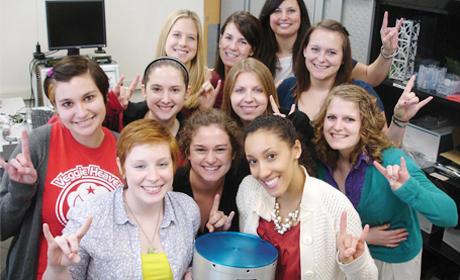 Six months ago, most members of the Women in Aerospace Leadership and Development (WIALD) student organization in the Department of Aerospace Engineering and Engineering Mechanics didn't know what an inertial measurement unit (IMU) was. Now, thanks to networking and a generous donation from Millennium Engineering and Integration Co. (MEI), they built three IMUs and launched them to the edge of space.
Six months ago, most members of the Women in Aerospace Leadership and Development (WIALD) student organization in the Department of Aerospace Engineering and Engineering Mechanics didn't know what an inertial measurement unit (IMU) was. Now, thanks to networking and a generous donation from Millennium Engineering and Integration Co. (MEI), they built three IMUs and launched them to the edge of space.
An IMU is an electronic device that measures and reports a spacecraft's velocity, orientation and gravitational forces. WIALD built three of these units and launched them aboard Space Loft 6, a mission funded by the Department of Defense Operationally Responsive Space (ORS) Office that offered the additional payload space required. The purpose of the project is to find Commercial Off The Shelf (COTS) products to construct an IMU. By testing more affordable versions of professional grade products, WIALD hopes future missions can quickly assemble IMUs with decreased cost and production time and still obtain accurate results.
The idea for the project began after Katie Lodrige, WIALD vice president, and Shaina Shapiro (B.S. ASE '11) interned with MEI at ORS offices in New Mexico this past summer, working with Launch and Range Chief Engineer Steven Buckley. After Katie and Shaina's successful eight weeks in New Mexico, MEI encouraged WIALD to consider an IMU payload as its next project and provided the funding.
After working hard to develop a proposal, WIALD's IMU payload was selected to launch aboard a ballistic rocket from Spaceport America in New Mexico. Reaching the edge of space once launched, the IMUs will capture and record important data to inform future ORS missions.
"This project is a big advance for us," said WIALD Founder Rebekah Sosland. "This IMU payload is going much higher in altitude than the camera we built last year. It will reach the edge of space and remain in zero-gravity for approximately four minutes."
In addition to providing hands-on experience for a group comprised of mostly underclassmen, the project has allowed for a great deal of leadership growth — one of the driving forces behind WIALD.
"We set deadlines and frequently go beyond our normal meeting times to hit our targets," said WIALD External Vice President Bryse Ed. "We have volunteer team leads for each part of the project who take on the responsibility of meeting MEI's requirements and keeping the larger group on track."
The women honed their networking and presentation skills on the project by asking for input from other engineers to create the most cost- and time-efficient IMUs.
"We've really had to network to make this project possible," Lodrige said. "We've asked for help from the Electrical Engineering Department and from many graduate students in our department."
While previous projects have provided the women with practical, hands-on experience, this year's project has provided a new set of professional skills to prepare them for industry positions. The team had to write a nine-page proposal and budget to set the project in motion and are required to write a report about their findings and deliver a formal presentation after the launch.
The women are extremely grateful for their alumni connections at MEI who made the project possible — Founder and Chairman, Brian McKee '80, Vice President of Corporate Development, Dan Deans '90, and Launch Integration Lead Engineer, Jill Marsh '09.
"Mentoring these women throughout the project has been a wonderful experience," Marsh said. "They are learning how to procure hardware, develop timelines, communicate and work as a team to design and assemble a complex system. This is exactly the type of experience industry demands and what MEI wants to see in future employees."
The big day finally arrived April 5 when WIALD's IMU payload was successfully launched at Spaceport America in New Mexico and reentered at White Sands Missile Range for retrieval and analysis.
"The launch was a huge success," said WIALD President Sarah Hand. "It launched at 8:18 a.m. on April 5. The flight was 14 minutes and reached a little over 73 miles high. This is above the earth's atmosphere, in real space. The rocket remained in space for four minutes and re-entered with a sonic boom. We have verified that all of our IMUs collected data and we will be processing it over the next couple of weeks. This was an unbelievable opportunity for the WIALD women and we learned so much from our experience."







